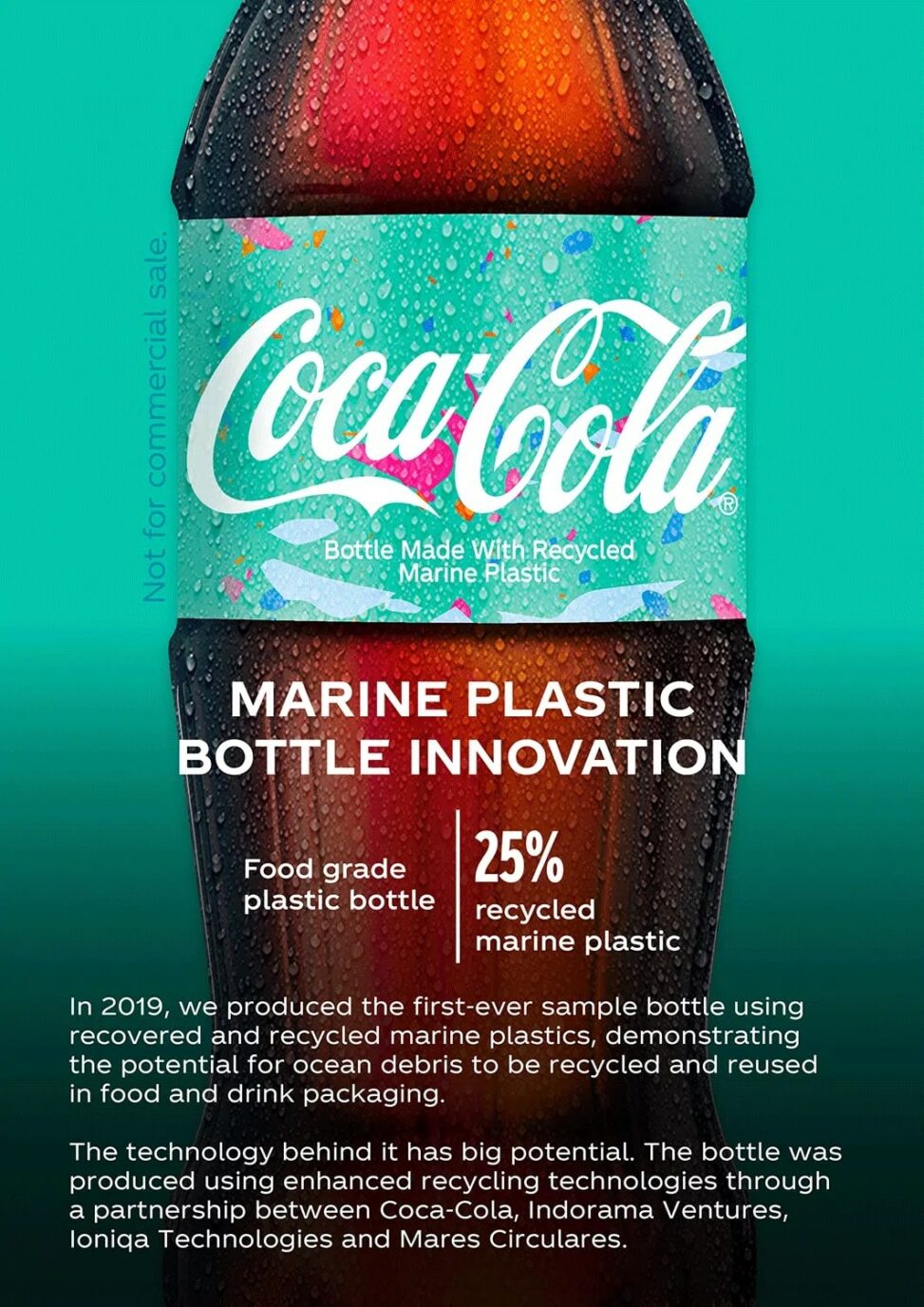In recent years, the phenomenon of greenwashing has become a focal point of criticism for many corporations. Among them, Coca-Cola stands out as a prime example. In 2019, the company launched a campaign that promoted its environmental initiatives, particularly focusing on advertising that the bottles are made from 25% recycled marine plastic. These ads were posted up in storefronts, shown on television advertisements and cell phones around the world.
These unique ads for Coca-Cola usually depict a new teal bottle with the words “bottles made with recycled marine plastic”, with major emphases on turning the signature bold red into a more environmentally pleasing green. Coca-Cola chooses to stick with its signature bottle shape and logo to help this product be easily identifiable as an official Coca-Cola product. If you pay close attention to the composition, you notice they choose to bring that dark void of a drink to light by smacking bright lights on the back of the bottle. Having it appear less as sewage and more a pleasing drink for the palette, and the environment! You will notice droplets of water which, may in turn have you thinking of hydration and the main focus of this ad, which is recycling marine plastic out of our ocean waters through Coca-Cola. This company is also clever, carefully making sure all the plastic bits in the image look clean and appealing to the eye. No imperfections with Coca-Cola here, which contributes to the company’s image as a whole.
These ads are used to make consumers believe that they are cutting their carbon footprint by choosing the new options of brighter bottles. The company wants them to associate their choice of drink with contributing positively to the environment, promoting the idea that buying Coca-Cola marine plastic bottles will align with their sustainable values. The advertisement seeks to convince the audience to purchase this product by relating to the overpopulation of plastic in our oceans. True or not it succeeds in at least connecting your brain to think and relate Coca-Cola with more environmentally friendly practices such as “marine plastic bottle innovation”.
The target audience for this ad is likely health-conscious consumers and young adults who are increasingly concerned with environmental and social responsibility pressured on them through social media and influencers. According to a study done by Cone Communication (2024), reveals that 95% of millennials and Gen Z are more likely to support brands that demonstrate social responsibility and sustainability. The social pressures of global warming and fear mongering through media can not only pressure them but cause this demographic to pressure others, creating a wave of more environmentally responsible people.
The minimalist design is most likely effective as it promotes a clear thinking space decluttering the whole image of tightly condensed shapes. Instead, leaving plenty of space between designs to help trick your mind into thinking you are really clearing the ocean…or maybe just the label. According to a report by Greenpeace (2020), Coca-Cola was found to be the top plastic polluter worldwide, contributing significantly to the global plastic waste crisis. Regardless of the action Coca-Cola takes, it is undeniable that they remain to be a major concern for the world’s initiative to “go green’.
With more than 500 brands available in more than 200 countries, Coca-Cola is the largest beverage manufacturer and distributor in the world, one of the largest corporations in the United States, and one of the most successful brands in marketing history. The brand is so powerful that regardless of the impact on the environment they will continue to flood our storefronts with the newest flavour or the new green initiative regardless of the actual impact it has on our environment. UC Berkeley research (2018), found that even fake money could make people behave with less regard for others. All research concludes that coca cola whether positively or negatively is here to stay.
Bibliography:
Laville Sandra. The Guardian. June 30, 2022. “Coca-Cola among brands greenwashing over packaging”.
https://www.theguardian.com/environment/2022/jun/30/coca-cola-among-brands-greenwashing-over-packaging-report-says#:~:text=Coca%2DCola%2C%20the%20report%20says,the%20world%27s%20biggest%20plastic%20polluter.
Morunga Aden, Greenpeace Aotearoa, September 26 2023. “Unbottling the Truth: Coca-Cola’s Role in Plastic Pollution.” https://www.greenpeace.org/aotearoa/story/unbottling-the-truth-coca-colas-role-in-plastic-pollution/.
Britannica, September 25, 2024. “The coca-cola company”.
https://www.britannica.com/money/The-Coca-Cola-Company
Gregoire Carolyn, greater good magazine, February 8, 2018. “How Money Changes the Way You Think and Feel”.
https://greatergood.berkeley.edu/article/item/how_money_changes_the_way_you_think_and_feel


MJ Ponte
Great job explaining how Coca-Cola uses greenwashing to make their product seem more environmentally friendly. I like how you pointed out the visuals, like the teal colour and the bright lights, which make the bottle and the drink look fresh and eco-friendly. You also did a good job explaining how Coca-Cola tries to connect with young, environmentally conscious consumers by making them feel like they’re helping the planet by choosing their product.
Your main argument is clear—that Coca-Cola is trying to appear green while still being one of the biggest contributors to plastic pollution. The sources you used, like Greenpeace and The Guardian, were helpful in backing up your points. I also liked that you included a study showing how younger people are influenced by social responsibility.
However, A bit more focus on how Coca-Cola’s actions don’t match their green claims would make your analysis even stronger.
Overall, you’ve done a solid job!